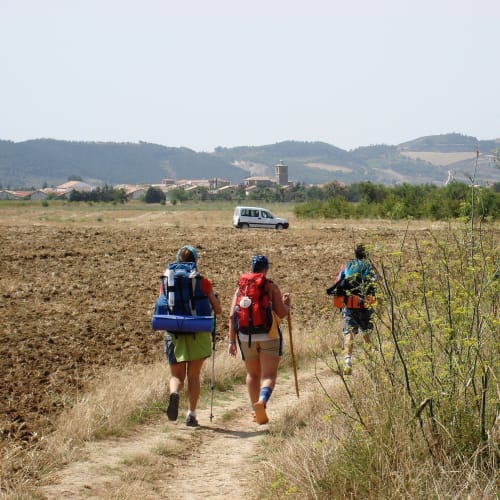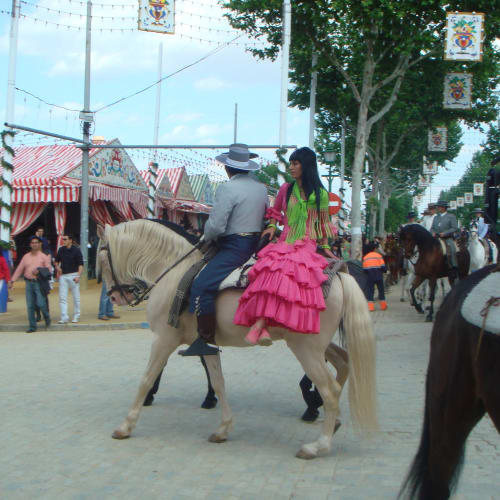Finding the Essence of Spain
April 2005




If you wanted to travel off the beaten track in Spain for a week or two to absorb the essence of the country, where would you go? This is not an easy question to answer, since Spain includes many different peoples: from redheaded men playing bagpipes in Galicia, to dark eyed señoritas in their flamenco dresses, riding sidesaddle at the ferias in Andalucía. It has seventeen autonomous regions, each with its own appeal.
Certainly, anyone's understanding of Spain is bound to be subjective. Since my family and I lived among the warm and gracious people of Andalucía, the region has a special place in my heart. I have images of the Giralda tower in Sevilla; the Alhambra palace and gardens of Granada; La Mesquita -the Mosque of Córdoba. I recall the pungent wine barrels in a sherry bodega next to our house, and the fishing boats bringing fresh seafood into the harbor. Andalucía is a fascinating part of Spain where the Moorish and Christian cultures converged; nevertheless, it is only a piece in the Spanish mosaic.

Before we lived in Cádiz, I would have defined the Spanish experience as walking the streets of Toledo at night on the same cobblestones trod by Visigoths and Moors; Jews and Christians; by El Greco and Alfonso the Wise. Or it is climbing up the fanciful castle of Segovia with my sons, or eating roast suckling pig in the shadow of a Roman aqueduct. But then again, is not Spain also the walled medieval town of Avila, or the broad Ramblas of Barcelona, or the Romanesque churches tucked in the valleys of the Pyrenees?
Where can you capture the essence of Spain? I suggest traveling the pilgrimage route that leads to the holy city of Santiago de Compostela. The Camino is a pathway that people of all sorts have trod for well over a thousand years. It spans northern Spain from the snow-capped Pyrenees to the windswept shores of Celtic Galicia. There in the pilgrim city of Santiago de Compostela lie the bones of St James, the patron saint of Spain. For Spaniards Santiago is the focus of the seven hundred year Reconquista of their land from the Moors.
In medieval times, as today, the pilgrims had many reasons for walking along the Road. From the furthest corners of Spain came penitents seeking to cleanse their sins at the Door of Pardon at the cathedral. Others made the long and arduous trip as a means of personal renewal, exclusive of any miraculous claims. Artists and artisans offered their handiwork along the route and employed their skills as architects and stonemasons --adorning buildings, building bridges or constructing churches and monasteries. /pantry-staples/preserves
Many others joined this stream of humanity that converged from all over Europe -- people of many lands, languages and cultures. Charlemagne traversed the Camino, as did some of the people written about in Chaucer's Canterbury Tales. The travelers must have enjoyed many of the traditional products still around today, such as arrop, membrillo, various chorizos, jamón and fig cakes.
While many consider walking to be the most authentic method to follow the Camino, you can still catch the flavor of the Camino by bicycle or car. Over the years, Ruth and I have wended our way by automobile through the many little towns and cities that sprung up along the path to serve the pilgrims.
We stayed in Santo Domingo de Calzada in the same inn that St Francis of Assisi visited. In León, we marveled at the thousand-year-old frescos in the royal pantheon of the Collegiate church of San Isidoro and we were bathed in the pure light of the stained glass of the classic gothic cathedral. We detoured from the main route to visit the Camera Santa in the cathedral in Oviedo deep in Asturias - for me it is one of the most evocative and holy places of all.

Our son Jonathan walked the 400 miles across Spain twelve years ago. Along the way, he met many Spaniards from Aragon, Navarra, Leon, and El Bierzo -- all the way to Santiago and the far shores of Galicia. One man he befriended was a young itinerant Brazilian who had been in many parts of the globe on his personal pilgrimage. Years later Jonathan returned to the Camino for his honeymoon.
Our family wanted to reflect this unifying event of the Spanish tradition so we chose the shell of Santiago as our La Tienda trademark. For the same reason we selected the Peregrino brand for our private label with its shell and crossed walking staffs.
In America there is an association named American Pilgrims on the Camino, which brings together people who have gained from the Santiago experience, or who are considering making the journey. They are about to publish a beautiful new magazine, Pilgrimage, concerning all aspects of pilgrimages, and are meeting for a week in Toronto beginning 10 May. Some of you might enjoy contacting them at their website. It is full of information about their gathering including aspects of spiritual retreat, and even training for those who want to return to the Camino to help other travelers on the Way.
The essence of Spain? Perhaps the Pilgrimage is an apt metaphor, and not only for Spain and its long struggle for unity, but also for each one of us as we travel through life. Should you choose to mix with the townspeople along the Camino you will experience the flavor of the centuries old traditions of the Spanish people.
Buen viaje,
Don

